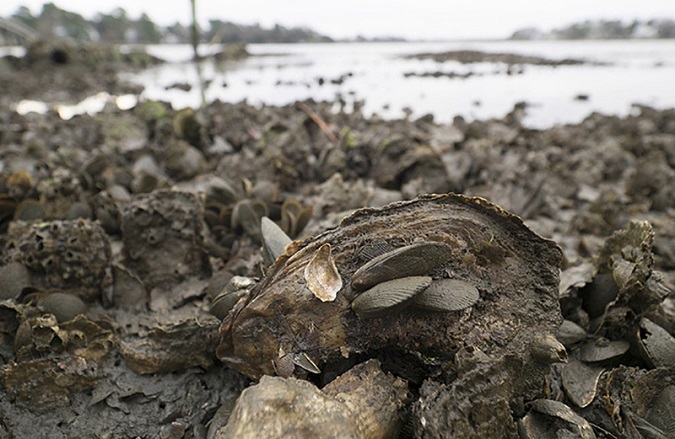Looking to build on the progress already made in restoring the Chesapeake’s depleted oyster population, a coalition of more than 20 nonprofit groups, businesses and educational institutions has set a new goal of putting another 10 billion bivalves in the Bay by 2025.
“Enormous benefits can accrue to the Bay by bringing the health of oysters back,” William Baker, Chesapeake Bay Foundation president, said in announcing the campaign Monday. “There’s been a good start over the last several years, but we want to set a very ambitious stretch goal and see if we can all work together to achieve it.”
As reef-building filter feeders, oysters help to improve water quality and provide food and habitat for finfish and other animals. But overharvesting, diseases and habitat loss have led to a severe decline, with their population now estimated to be at 1 or 2 percent of historical levels.
 The campaign aims to boost the Bay’s oyster population for both its ecological and economic value, with support for further reef restoration, expansion of the aquaculture industry and sustainable management of the wild commercial fishery.
The campaign aims to boost the Bay’s oyster population for both its ecological and economic value, with support for further reef restoration, expansion of the aquaculture industry and sustainable management of the wild commercial fishery.
Under the 2014 Chesapeake Bay Watershed Agreement, Maryland and Virginia each pledged to restore oyster habitat and populations in five of their tributaries by 2025. That effort is not even halfway to its goal, and funding to continue it has diminished in recent years.
Restoration work is complete in Maryland’s Harris Creek and nearing completion later this year in Virginia’s Lafayette River and Maryland’s Little Choptank River. Work is under way in three other tributaries, and the two states recently identified the remaining four tributaries to be targeted – the St. Mary’s River and Breton Bay in Maryland and the lower York River and Great Wicomico River in Virginia.
In the last six years, about 4 billion hatchery-produced “spat” or baby oysters have been planted in the three Maryland tributaries that have undergone restoration work, according to preliminary figures presented to a Chesapeake Bay Program panel last December; no comparable tally has been made in Virginia, where rebuilt reefs are generally populated by natural reproduction rather than with hatchery-produced spat.
There is no reliable count of how many oysters are in the Bay now. Maryland’s Department of Natural Resources is working on a legislatively mandated stock assessment that should provide a population estimate for that state’s waters.
Donald Boesch, marine science professor with the University of Maryland Center for Environmental Science, noted that a 2011 study by one of his colleagues estimated that there were 850 million adult oysters in the Maryland portion of the Bay. Boesch believes that reaching the campaign goal could double or even triple the Bay’s overall existing oyster population. He’s confident that the oyster hatchery at the UMCES Horn Point laboratory, with the help of the nonprofit Oyster Recovery Partnership, could itself produce and plant 2 billion spat on shell annually.
“So,” Boesch concluded, “funding, shell for setting [oysters] and political will to do the restoration in the most effective and efficient way are the limiting factors.”
Restoration work in Maryland has been marked by controversy, though, as watermen have held up some restoration projects because reefs were being built with stone instead of natural oyster shells, which are in short supply.
Baker acknowledged that funding also could be a challenge to achieving the 10 billion goal, as federal funding for oyster restoration went from $5 million annually at one time to near zero in the last two years. One aim of the campaign, he said, is to lobby Congress to continue and even increase money for restoration, as well as more research and monitoring.
“We don’t know [how many oysters are in the Bay],” he said. “Part of this project will be to bring greater scientific clarity to answer that.” Maryland is currently conducting its first comprehensive oyster population assessment, which is to be completed by the end of the year.
Johnny Shockley, founding partner of the Hoopers Island Oyster Co., one of Maryland’s leading aquaculture firms, said oyster farming could play a big role in meeting the 10 billion goal while also boosting the region’s economy.
Even though the oysters grown by aquaculture operations are only in the Bay for two to three years, they still filter algae and sediment as they grow to market size.
Shockley noted that Maryland’s aquaculture industry increased its production by 29 percent in 2017 over the previous year and predicted it would soon overtake the wild oyster harvest, something Virginia’s oyster farmers already have done in the lower end of the Bay.
“This partnership promotes small business, creates jobs and maintains oyster growers’ long-term viability,” he said. “We see a future when the Chesapeake once again leads the world in seafood productions with hundreds of oyster farms and a sustainable public fishery that preserves our heritage and builds a billion-dollar industry.
John Racanelli, chief executive officer of the National Aquarium in Baltimore, said the growth of oyster farming could have spillover economic benefits through tourism. He noted that shellfish farms are among the prime attractions around Tomales Bay, a popular destination on the northern California coast.
Karen Forget, executive director of Lynnhaven River NOW, a nonprofit group working to restore the ecological health of that waterway in Virginia Beach, said the campaign dovetails with the efforts of community groups like hers. She said they have built 60 acres of sanctuary reef in the river and worked with school groups to put millions of oysters on it.
“Our work in reducing pollutants entering the river is measured by the areas open to shellfish harvest,” she said, “and those areas have grown from 1 percent in 2002 to 46 percent in 2018.”
For more on the campaign, go here.
By Timothy B. Wheeler, the managing editor and project writer for the Bay Journal. He has more than two decades of experience covering the environment for The Baltimore Sun and other media outlets.
